Filter News
Area of Research
- Advanced Manufacturing (7)
- Biological Systems (3)
- Biology and Environment (119)
- Biology and Soft Matter (4)
- Building Technologies (3)
- Chemical and Engineering Materials (3)
- Chemistry and Physics at Interfaces (7)
- Clean Energy (208)
- Climate and Environmental Systems (7)
- Computational Biology (1)
- Computational Chemistry (5)
- Computational Engineering (2)
- Computer Science (4)
- Data (1)
- Earth Sciences (1)
- Electricity and Smart Grid (2)
- Energy Frontier Research Centers (7)
- Energy Sciences (2)
- Fuel Cycle Science and Technology (2)
- Functional Materials for Energy (10)
- Fusion and Fission (43)
- Fusion Energy (7)
- Geographic Information Science and Technology (1)
- Isotopes (24)
- Materials (186)
- Materials Characterization (2)
- Materials for Computing (17)
- Materials Synthesis from Atoms to Systems (8)
- Materials Under Extremes (8)
- National Security (53)
- Neutron Data Analysis and Visualization (2)
- Neutron Science (83)
- Nuclear Science and Technology (35)
- Quantum Condensed Matter (3)
- Quantum information Science (5)
- Renewable Energy (2)
- Sensors and Controls (2)
- Supercomputing (172)
- Transportation Systems (6)
News Type
News Topics
- 3-D Printing/Advanced Manufacturing (52)
- Advanced Reactors (13)
- Artificial Intelligence (53)
- Big Data (25)
- Bioenergy (55)
- Biology (63)
- Biomedical (32)
- Biotechnology (10)
- Buildings (22)
- Chemical Sciences (32)
- Clean Water (14)
- Climate Change (54)
- Composites (10)
- Computer Science (96)
- Coronavirus (21)
- Critical Materials (2)
- Cybersecurity (20)
- Decarbonization (46)
- Education (1)
- Emergency (2)
- Energy Storage (43)
- Environment (114)
- Exascale Computing (26)
- Fossil Energy (4)
- Frontier (26)
- Fusion (36)
- Grid (26)
- High-Performance Computing (53)
- Hydropower (5)
- Irradiation (1)
- Isotopes (32)
- ITER (3)
- Machine Learning (23)
- Materials (71)
- Materials Science (62)
- Mathematics (5)
- Mercury (7)
- Microelectronics (2)
- Microscopy (28)
- Molten Salt (2)
- Nanotechnology (28)
- National Security (40)
- Net Zero (9)
- Neutron Science (58)
- Nuclear Energy (65)
- Partnerships (19)
- Physics (32)
- Polymers (13)
- Quantum Computing (20)
- Quantum Science (32)
- Renewable Energy (1)
- Security (13)
- Simulation (33)
- Software (1)
- Space Exploration (13)
- Summit (32)
- Sustainable Energy (51)
- Transformational Challenge Reactor (4)
- Transportation (36)
Media Contacts
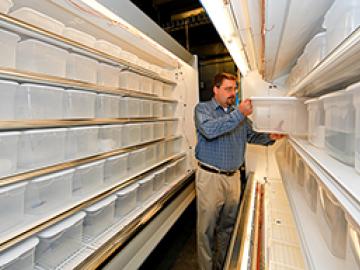
Keeping food fresh is no easy feat. Trials of transporting ice over long distances and the hazards of systems that rely on toxic gases riddle the pages of refrigeration history. And although cooling science has come a long way in the past two centuries, modern refrigeration has an environmental cost...

For students learning about multicore computers like Titan, the second-most powerful computer in the world, Tiny Titan can make the task a bit more manageable. The sub-$1,000 classroom computer can help middle and high school students explore the fundamental concepts of parallel ...

Researchers at the Department of Energy’s Oak Ridge National Laboratory got a surprise when they built a highly ordered lattice by layering thin films containing lanthanum, strontium, oxygen and iron. Although each layer had an intrinsically nonpolar (symmetric) distribution of electrical charges, the lattice had an asymmetric distribution of charges. The charge asymmetry creates an extra “switch” that brings new functionalities to materials when “flipped” by external stimuli such as electric fields or mechanical strain. This makes polar materials useful for devices such as sensors and actuators.
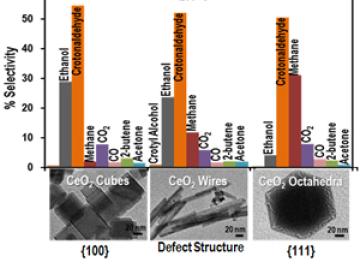
Scientists at the Department of Energy’s Oak Ridge National Laboratory have discovered they can control chemical reactions in a new way by creating different shapes of cerium oxide, a rare-earth-based catalyst.
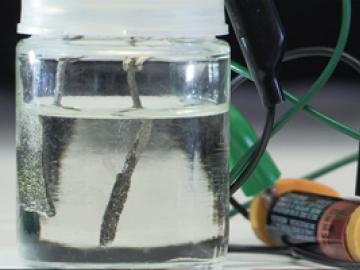
In 2015, American consumers will finally be able to purchase fuel cell cars from Toyota and other manufacturers. Although touted as zero-emissions vehicles, most of the cars will run on hydrogen made from natural gas, a fossil fuel that contributes to global warming.

depth, population-based approach to identifying such mechanisms for adaptation, and describes a method that could be harnessed for developing more accurate predictive climate change models. For the U.S. Department of...
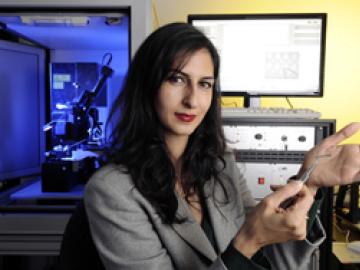
If such a designation existed, Nazanin Bassiri-Gharb would be on the fast track to becoming an Oak Ridge National Laboratory “super user.” Her research on nanoscale materials has taken her all across the ORNL campus, from scanning probe and electron microscopes at the Center for Nanophase Materials Sciences to neutron reflectometry at the Spallation Neutron Source and radiation equipment in the Materials Science and Technology Division.
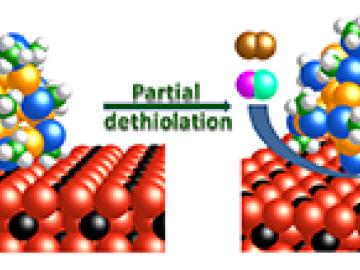
Old thinking was that gold, while good for jewelry, was not of much use for chemists because it is relatively nonreactive. That changed a decade ago when scientists hit a rich vein of discoveries revealing that this noble metal, when structured into nanometer-sized particles, can speed up chemical reactions important in mitigating environmental pollutants and producing hard-to-make specialty chemicals.
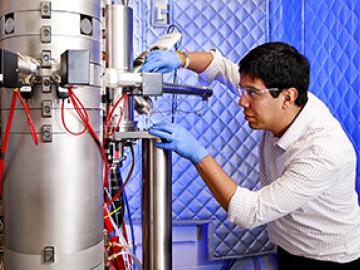
Juan Carlos Idrobo, a researcher at the Department of Energy's Oak Ridge National Laboratory, has been recognized by the Hispanic Engineer National Achievement Award Corporation with the 2014 Outstanding Technical Achievement Award for groundbreaking research in scanning transmission electron microscopy of 2D materials.
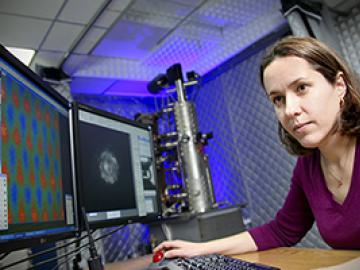
Maria Varela, a researcher at the Department of Energy's Oak Ridge National Laboratory, has received the Microscopy Society of America's Burton Medal for early career scientists.




